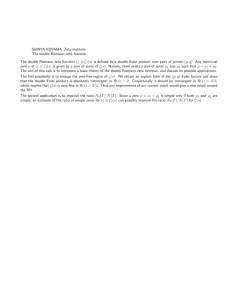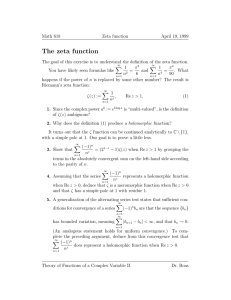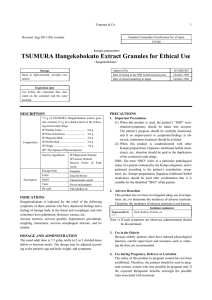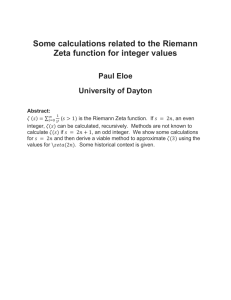INTEGERS 10 (2010), 879-882 #A59 A NOTE ON COLORED TORNHEIM’S DOUBLE SERIES
advertisement
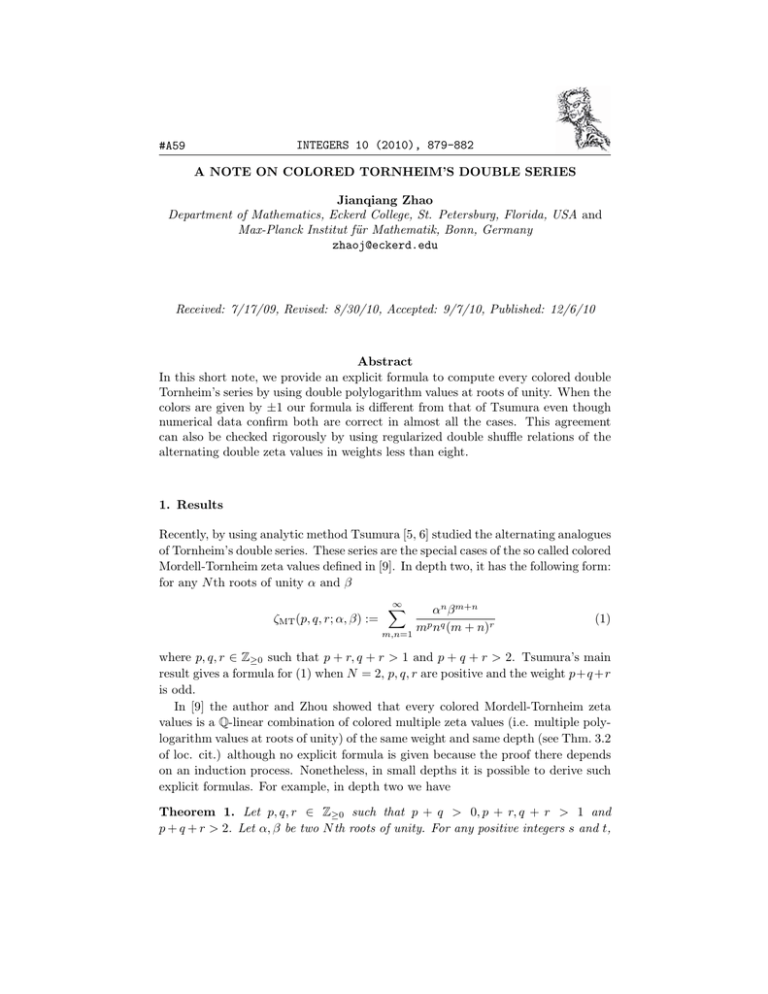
INTEGERS 10 (2010), 879-882 #A59 A NOTE ON COLORED TORNHEIM’S DOUBLE SERIES Jianqiang Zhao Department of Mathematics, Eckerd College, St. Petersburg, Florida, USA and Max-Planck Institut für Mathematik, Bonn, Germany zhaoj@eckerd.edu Received: 7/17/09, Revised: 8/30/10, Accepted: 9/7/10, Published: 12/6/10 Abstract In this short note, we provide an explicit formula to compute every colored double Tornheim’s series by using double polylogarithm values at roots of unity. When the colors are given by ±1 our formula is different from that of Tsumura even though numerical data confirm both are correct in almost all the cases. This agreement can also be checked rigorously by using regularized double shuffle relations of the alternating double zeta values in weights less than eight. 1. Results Recently, by using analytic method Tsumura [5, 6] studied the alternating analogues of Tornheim’s double series. These series are the special cases of the so called colored Mordell-Tornheim zeta values defined in [9]. In depth two, it has the following form: for any N th roots of unity α and β ζMT (p, q, r; α, β) := ∞ ! αn β m+n mp nq (m + n)r m,n=1 (1) where p, q, r ∈ Z≥0 such that p + r, q + r > 1 and p + q + r > 2. Tsumura’s main result gives a formula for (1) when N = 2, p, q, r are positive and the weight p+q +r is odd. In [9] the author and Zhou showed that every colored Mordell-Tornheim zeta values is a Q-linear combination of colored multiple zeta values (i.e. multiple polylogarithm values at roots of unity) of the same weight and same depth (see Thm. 3.2 of loc. cit.) although no explicit formula is given because the proof there depends on an induction process. Nonetheless, in small depths it is possible to derive such explicit formulas. For example, in depth two we have Theorem 1. Let p, q, r ∈ Z≥0 such that p + q > 0, p + r, q + r > 1 and p + q + r > 2. Let α, β be two N th roots of unity. For any positive integers s and t, 2 INTEGERS: 10 (2010) we define the double polylogarithm value Lis,t (β, α) = Then " β m αn /(ms nt ). m>n≥1 $ p−1 # ! q+a−1 ζMT (p, q, r; α, β) = Lir+q+a,p−a (αβ, α−1 ) a a=0 $ q−1 # ! p+b−1 + Lir+p+b,q−b (β, α). b (2) b=0 Proof. We have the following well-known combinatorial identity (for e.g., see [3, p. 48]): $ $ p−1 # q−1 # ! ! 1 q+a−1 1 p+b−1 1 = + p−a (x + y)q+a q−b (x + y)p+b xp y q x y a b a=0 b=0 for any two positive integers p and q and any two real numbers x and y such that x + y #= 0. This immediately yields the decomposition $ p−1 # ! q+a−1 αn β m+n a mp−a (m + n)r+q+a a=0 $ q−1 # ! p+b−1 αn β m+n + b nq−b (m + n)r+p+b ζMT (p, q, r; α, β) = b=0 which gives (2), as desired. In [6, 7] Tsumura defines R(p, q, r) := ∞ ! (−1)n , p m nq (m + n)r m,n=1 S(p, q, r) := ∞ ! m,n=1 (−1)m+n , + n)r mp nq (m which are two special cases of ζMT (p, q, r; α, β) when N = 2. Define ζ(p, q) := ! (−1)m+n , mp nq m>n≥1 ζ(p, q) := ! (−1)m , mp nq m>n≥1 Then the next corollary follows from Theorem 1 at once. ζ(p, q) := ! (−1)n . mp nq m>n≥1 3 INTEGERS: 10 (2010) Corollary 2. Let p, q, r ∈ Z≥0 such that p + q > 0, p + r, q + r > 1 and p + q + r > 2. Then $ p−1 # ! q+a−1 R(p, q, r) = ζ(r + q + a, p − a) a a=0 $ q−1 # ! p+b−1 + ζ(r + p + b, q − b), b b=0 $ p−1 # ! q+a−1 S(p, q, r) = ζ(r + q + a, p − a) a a=0 $ q−1 # ! p+b−1 + ζ(r + p + b, q − b). b b=0 For example, we have R(1, 1, 3) =ζ(4, 1) + ζ(4, 1), R(1, 2, 2) = ζ(4, 1) + ζ(3, 2) + ζ(4, 1), R(1, 1, 5) =ζ(6, 1) + ζ(6, 1), R(2, 1, 2) = ζ(3, 2) + ζ(4, 1) + ζ(4, 1), R(2, 3, 2) =ζ(5, 2) + 3ζ(6, 1) + ζ(4, 3) + 2ζ(5, 2) + 3ζ(6, 1), R(1, 2, 4) =ζ(6, 1) + ζ(5, 2) + ζ(6, 1), R(1, 3, 3) =ζ(6, 1) + ζ(4, 3) + ζ(5, 2) + ζ(6, 1), R(2, 1, 4) =ζ(5, 2) + ζ(6, 1) + ζ(6, 1), R(1, 4, 2) =ζ(6, 1) + ζ(3, 4) + ζ(4, 3) + ζ(5, 2) + ζ(6, 1), [3pt]R(2, 2, 3) =ζ(5, 2) + 2ζ(6, 1) + ζ(5, 2) + 2ζ(6, 1), R(3, 1, 3) =ζ(4, 3) + ζ(5, 2) + ζ(6, 1) + ζ(6, 1), R(3, 2, 2) =ζ(4, 3) + 2ζ(5, 2) + 3ζ(6, 1) + ζ(5, 2) + 3ζ(6, 1), R(4, 1, 2) =ζ(3, 4) + ζ(4, 3) + ζ(5, 2) + ζ(6, 1) + ζ(6, 1). Recently Blümlein, Broadhurst and Vermaseren [1] have built tables of relations for (alternating) multiple zeta values and so one can rigorously check if the above data agree with those in [6] or not. When the weight is ≤ 7 these relations can be produced by using regularized double shuffle relations (see [4] or [8]). We also have verified this agreement numerically by EZface [2] except that R(2, 1, 2) = 1 2 −.2402184755 · · · by our formula while R(2, 1, 2) = 45 16 ζ(5) − 4 π ζ(3) = INTEGERS: 10 (2010) 4 −.0495972141 · · · by the second line on [6, p. 90]. With Maple it is easy to compute this value directly by the series definition and see that our value is correct. In fact, by using regularized double shuffle relations we get R(2, 1, 2) = 5 2 ζ(3, 2) + ζ(4, 1) + ζ(4, 1) = 107 32 ζ(5) − 16 π ζ(3). Acknowledgement. The author wishes to thank Vermaseren for verifying the identities involving alternating double zeta values and the anonymous referee for several very helpful suggestions. He also thanks Max-Planck-Institut für Mathematik for providing financial support during his sabbatical leave when this work was done. References [1] J. Blümlein, D.J. Broadhurst and J.A.M. Vermaseren, The multiple zeta value datamine, Computer Physics Communications, 181 (2010), 582-625. [2] J. Borwein, P. Lisonek, and P. Irvine, An interface for evaluation of Euler sums. Available online at http://oldweb.cecm.sfu.ca/cgi-bin/EZFace/zetaform.cgi [3] N. Nielsen, Die Gammafunktion. Band I. Handbuch der Theorie der Gammafunktion. Band II. Theorie des Integrallogarithmus und verwandter Transzendenten, Chelsea, New York, 1965. [4] G. Racinet, Doubles mélanges des polylogarithmes multiples aux racines de l’unité, Publ. Math. IHES 95 (2002), 185-231. [5] H. Tsumura, On alternating analogues of Tornheim’s double series, Proc. AMS 131 (2003), 3633–3641. [6] H. Tsumura, On alternating analogues of Tornheim’s double series II, Ramanujan J. 18 (2009), 81–90. [7] H. Tsumura, Evaluation Formulas for Tornheim’s Type of Alternating Double Series, Math. Computation, 73 (2004), 251-258. [8] J. Zhao, Standard relations of multiple polylogarithm values at roots of unity, Documenta Mathematica 15 (2010), 1-34. [9] J. Zhao and X. Zhou, Reducibility of signed cyclic sums of Mordell-Tornheim zeta and Lvalues, Max Planck Ins. Math. Preprint MPIM2009-8, 2009. arxiv: 0902.1262.



